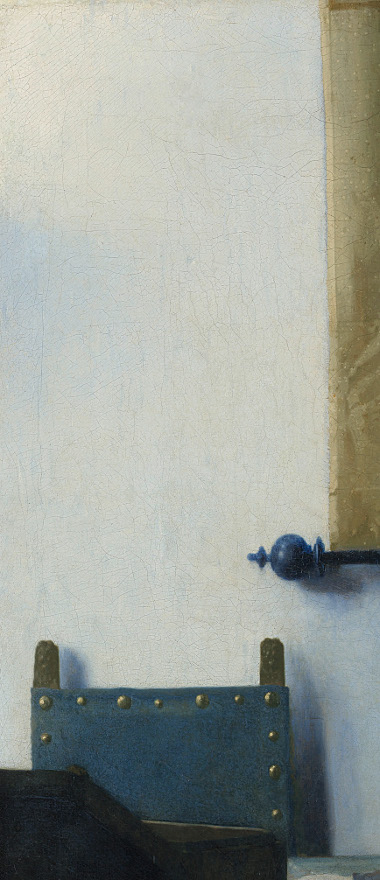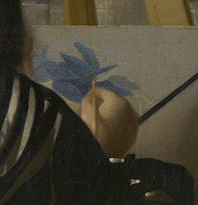Details: Vermeer's Painting Technique
WOMAN IN BLUE READING A LETTER
c. 1662-1665
oil on canvas
18 1/4 x 15 7/8 in. (46.5 x 38 cm.)
The Rijksmuseum, Amsterdam
painting a white wall
In oil painting, the naturalistic rendering of a brightly lit wall, such as those found in the works of Pieter de Hooch or Vermeer, is a challenging undertaking. However, while De Hooch depicted his walls in a fairly rough and standardized manner, Vermeer experimented with a more refined and broader range of techniques just as he had done with others of his preferred motifs (e.g. leaded windows, floor tiles, wall maps etc.). Vermeer’s exceptional powers of observation and pictorial synthesis allowed him capture nuances of light, shade and texture in his dipictions of walls that De Hooch either ignored or was unable to represent.
In Vermeer’s walls, the broader left-to right chiaroscural variation immediately establishes the direction and intensity of the incoming light and how it gradually diminishes as it rakes obliquely its surface. Nail holes, cracks, crevices and other minor surface irregularities are recorded with discreet variations in the paint’s tonal values. In some works, such details are "literally" depicted with darker and lighter paint, in others by digging the stiff-bristled brush into the wet, light-toned paint exposing here and there the underlying darker ground.1
Sometimes paint is used metaphorically. By piling up thick paint impasto in the lighter areas of the wall,2 the painter evoked not only the strength of the light which illuminates its surface but their crusty texture produced by repeated coating of lime which necessary to maintain the walls clean, fully reflective and hygienic.3 Minor cast shadows, instead, were often painted with thin, semi-transparent layers of darker paint in order to cinvey their insubstantial nature. The contours, tones and shapes of the shadows cast by the widows, painting-within-paintings and maps hung upon the walls provide more precise information about the intensity and direction of the light as well as information about the morphological characteristics of the objects themselves.4
The base hue of each wall, given by the relative coolness or warmth of the basic gray paint used to represent them, determines not so much the quantity of the light as its quality, or rather, its temperature. In the most successful renditions, it is possible to understand what time of day the painter intended to represent. For example, the bluish shadows and clean, light tones of the wall (and wall map) in the Officer and Laughing Girl denote cool morning light. The effect is further enhanced by the striking bluish tint of the shadows on the lady’s face and of her white head covering. The frosty blues (painted with natural ultramarine pigment) of the Woman in Blue Reading a Letter, which insinuate themselves in almost ever part of the composition, speak of morning light as well.
On the other hand, the pearl-gray of the shadows cast by the background chair and overall mute but warm gray of the wall of the Woman with a Pearl Necklace suggest afternoon light or an overcast day. The subdued ochres and brownish shadows of the night side of the lady’s yellow jacket confirm this impression. In Vermeer’s late works, the walls are handled with thinner layers of paint which show only faint relief and modeling. One of the principal characteristics which makes Vermeer’s walls so real in comparison to those of his contemporaries is the correct matching of the wall’s and the figures’ temperatures.
- See the Lady Writing a Letter. payoff." These marks were termed "nonsemantic" by the art historian, Whitney Davis.
- The Milkmaid and The Art of Painting
- See the Lady Writing a Letter.
- The double shadows cast by the frame of the London Lady Standing indicates light entered the room from two distant windows. The not quite comprehensible double shadows of the mirror depcted in Gabriel Metsu’s A Woman Reading a Letter with her Miaid underline how carefully observed were those of Vermeer.

